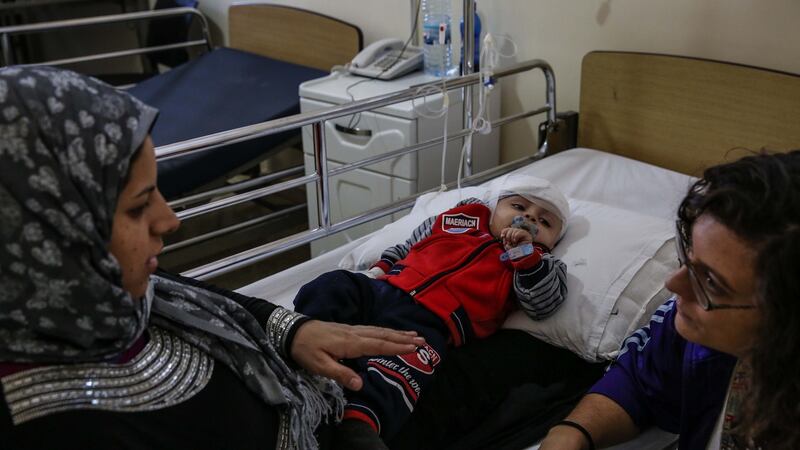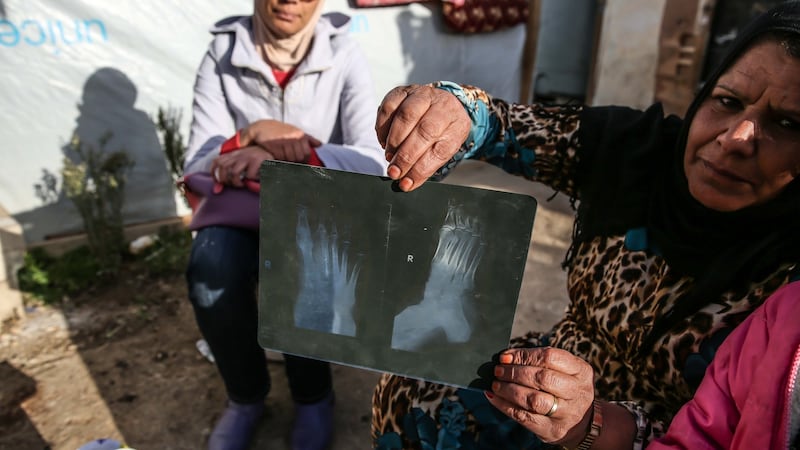Stuck between war and a state that doesn’t want them, Syrian refugees are learning a new normal.
In the darkness of a tent less than 30km from the Syrian border, Daghrit (15) is reading an essay she wrote about her time as a child labourer: “We’re tired, from morning until evening. In this very hard world we do not have time to rest.”
Daghrit spent four months working in potato fields after her family escaped the war in their homeland and arrived in Lebanon’s Bekaa Valley. She recalls nine-hour-long days in the burning sun, a continuous ache in her back from bending low to carry crops – and the equally burdensome weight of having to support her family.


The tent is a makeshift classroom filled with “young reporters”, children who have come together with the support of Lebanese charity Beyond to write a community newspaper. One by one, they stand up to expatiate on the problems associated with their new lives: early marriage, traumatised family members, or simply how desperately they miss their homes.
“I am a child. They bombed my house and killed my father, left me without rights and hope,” reads Ali Habar, a tiny 10-year-old who dreams of becoming a doctor.
Behind him, Waed (15) has written a poem about Omran Daqneesh, the bloody, shell-shocked five-year-old boy from Aleppo whose picture provoked sympathy all over the world. "What if Omran was from a country that was in the West?" she asks. "Would you do something or just deny the issue?"
Still recovering
Since war broke out in 2011, 1.5 million Syrians have fled into Lebanon, a country seven times smaller than Ireland that is still recovering from its own civil war.
Lebanon now has the highest per capita number of refugees of any state in the world. Services are overburdened but the world’s attention is turning elsewhere. The charities and international organisations still operating there struggle over how to even define a humanitarian situation with no end in sight.
"With protracted 'emergencies', language fails us a little," says Salam Abdulmunem of the UN children's agency Unicef. "After five years this isn't anymore an emergency as it would be defined in the dictionary, and with the impact [it is having] on Lebanese families and children, it hasn't been an 'emergency' for only Syrian families."
Abdulmunem says the UN’s work in Lebanon has reorientated towards “stabilisation”, assisting local government institutions and systems to respond to the needs of vulnerable children and families. The aim is to “strengthen local capacities and ensure that we leave something meaningful behind for Lebanon once this ‘emergency’ has been resolved.”
Meanwhile, the Lebanese government is growing increasingly hostile towards Syrians. New arrivals require Lebanese sponsors, and refugees who manage to enter face numerous restrictions, including a ban on employment. Since 2014, Syrians older than 15 also have to pay $200 (€186) a year to renew their residency permits – a crippling fee for many.
A 2016 study by UN refugee agency UNHCR found that 71 per cent of Syrians in Lebanon live below the poverty line. The majority stay in settlements – camps that can be shut by authorities at little notice, often for “security” reasons.
Living conditions
Mona al-Shamali, a 52-year-old with a wizened face and gold tooth, wouldn’t let her picture be taken because she’s embarrassed about her living conditions. Walking to the hardened mud field in front of her tent, she sits down on a brown, fleece-lined cushion that used to lie beside her stove in Homs.
“It was a journey filled with sadness and tiredness,” she says, remembering leaving her home in winter, 2013. “Hearing the bombs now and then and hearing the children crying. All I could do was just get the children and get out.”
Shamali has seven children and six grandchildren, some of whom share her tent with her. One newborn is asleep in a corner, hand curled in a fist. Another baby crawls on the ground outside, digging up dirt with both hands.
“There is no integration but also no fear,”she says of the situation for Syrians in Lebanon. Her most pressing concern is the cost of living. She pays €95 a month for a basic shelter and €50 for electricity – payments that have now been missed numerous times. She worries that the family will soon be evicted.
Health problems exacerbate the issue. Shamali’s husband is disabled; he lost fingers in a factory accident before the war. Shamali has a sewing machine, but eye problems mean prevent her from using it.
The family is in the same situation as many Syrians, plummeting from a comfortable middle-class existence to a life of destitution, and there is no rulebook for dealing with it. "All my children in Syria were literate and in high grades but they didn't finish their studies," Shamali says.
Her daughters had to flee the conflict before sitting their final exams. Unable to attend university, they instead got married. Both now do irregular farm work in Lebanon but feel their options closing.
The next Aleppo
In the nearby El Marj settlement, former builder Abdullah Faiz Aljasim (29) breeds pigeons to earn money to pay tent rent. He comes from east Ghouta, a Damascus suburb commentators have suggested could be the "next Aleppo" because of a major Syrian army offensive there.
Aljasim’s mother Finti serves grainy coffee in small china cups before hunkering down on pieces of wood beside their shelter. Later she takes out an X-ray to show where shrapnel lodged inside her foot when her house was shelled. “Every time I go to the hospital they charge me more,” she says.
Speaking at a nearby hospital, Laran Matta, a co-ordinator with Lebanon-based aid agency Salem LADC, is not surprised to hear this: Syrians are often overcharged by hospitals under pressure from all the extra patients, she says.
Residents in the Bekaa Valley complain of an increase in garbage and petty crime, and blame the refugee influx. They’re also resentful of Syrians for taking low-skilled jobs. “There are too many people in too small a space,” one local comments.
Moving around Lebanon is difficult for undocumented refugees. Tensions erupt in a minibus back to Beirut from Chtaura, a town in the Bekaa Valley. Pulling into a petrol station, the driver – a jovial man who was singing moments before – starts shouting at a Syrian man who is unable to provide valid papers.
It isn’t only the relationship between Syrians and the Lebanese that is increasingly strained.
Shatila, a labyrinthine refugee slum in Beirut, the capital, houses two generations of refugees. The camp was initially set up in 1949 for several thousand Palestinians. Syrian refugees began flocking there shortly after the war began in 2011, doubling the camp’s population by 2014, according to aid workers.
As many as 42,000 people now live in Shatila, in an area of less than one square kilometre.
Restrictions on space mean buildings have been growing upwards instead of outwards. Electrical wires stretch across the streets, bringing intermittent power to the cramped, damp flats. Nicknamed “spaghetti” by local aid workers, the overhanging wires can be deadly: at least three people were electrocuted in the last three months of 2016.
Little interaction
The narrow pathways are busy with vendors selling fruit, vegetables and homewares. But residents say they are worried about the power of local gangs and a lack of opportunities. And surprisingly, given the close living situations, many Syrians say there is little interaction between residents. Each family looks out for themselves, one says.
In Shatila’s community centre, dozens of women with babies are crammed into a corridor awaiting vaccinations. Prue Coakley, project co-ordinator with Médecins Sans Frontières, says it is harder and harder for Syrians in Shatila to access healthcare.
Irish Aid, the Department of Foreign Affairs’s overseas development programme, works in conjunction with the Trócaire to help mothers find sewing work and provide food baskets for families in need.
“‘The Syrian people are undergoing unimaginable suffering on a daily basis,” says Joe McHugh, Ireland’s Minister of State for International Development. “In many cases they, have been forced to leave their homes and travel to neighbouring countries where they face an uncertain future.
“Countries like Lebanon are bearing a huge burden because of this crisis,” he adds, “with many millions of additional refugees placing massive strain on already stretched resources.”
In 2016, Ireland provided more than €25 million in humanitarian assistance for people affected by the crisis in Syria. McHugh says the focus was on supporting host countries to provide opportunities for refugees within their borders.
Not like home
While aid from Ireland and other sources may offer short-term relief, hostility will continue to exacerbate refugees’ feelings that Lebanon could never be home.
Outside Shatila, a Lebanese taxi driver shouts after a trio of Syrian women who failed to pay him the full fee he asked for. “Stupid Syrians,” he loudly concludes. Across town, in the Beirut shopping district Hamra, a Lebanese shopkeeper advises some lost tourists not to trust another man’s directions: “He’s Syrian; he wouldn’t know.”
Back in Bekaa Valley, mere miles from her homeland but eons from her old life, Mona al-Shamali chooses not to comment on whether she hopes to ever return to Syria. Instead, she ruminates on the country’s scenic landscapes, the happy times she spent in the home where her children were born, and Homs, the city where she dreamed she would grow old.
“I had a good life there,” she says. “It was so beautiful. So many good things.”













